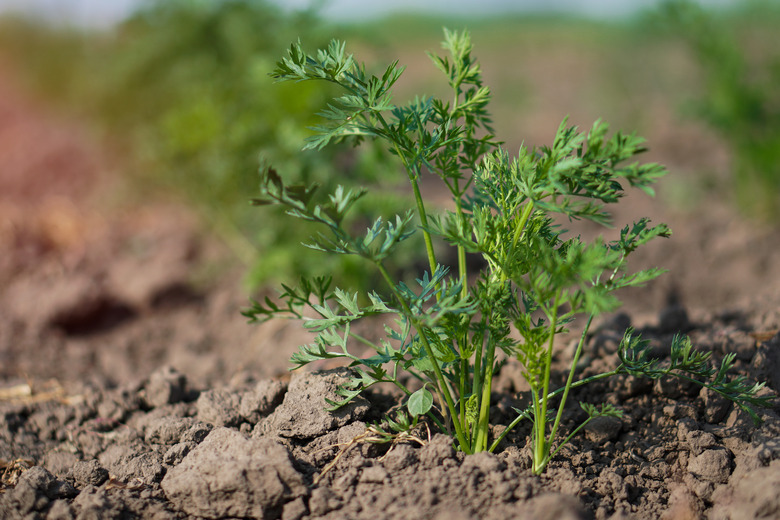Characteristics Of A Carrot Plant
There are many different varieties of the carrot plant. The orange carrots we know today were first cultivated for food 500 years ago in the Netherlands.
The orange part that we mainly eat is called the taproot, but the green leaves are also edible. Carrots also come in purple, red, white and yellow types.
Carrot Characteristics
Carrot Characteristics
Carrots are a root vegetable that grows low to the ground. The carrots we eat usually consist of about 88 percent water, 7 percent sugar, 1 percent protein, 1 percent fiber, 1 percent ash and 0.2 percent fat.
**Carrots store energy in their taproot.** The size and shape of a carrot are influenced by the environment the carrot grows in.
Leaves
Leaves
**The leaves of carrots can reach up to 3.28 feet (1 meter) in above ground height.** The leaves contain chlorophyll, which gives them their green color. Specialized cells in plant leaves are responsible for photosynthesis, which converts light, water and carbon dioxide into glucose for energy, oxygen and water.
The leaves are also involved in transpiration, which is when water is passively drawn up through the roots, through the leaves and then evaporates into the atmosphere.
The Root
The Root
Carrot roots get their coloration from a pigment called beta-carotene. When humans eat carrots, we convert the beta-carotene into vitamin A, which is essential for healthy eyes, bones, teeth and skin. Humans who eat too many carrots may have their skin turn a yellowish orange color. This is called carotenemia.
When you cut a carrot root in half, you can easily see the circular central core which contains the **xylem** and phloem. Phloem channels in the root transport sugars around the plant. The roots also passively move nutrients and water from the soil to the rest of the plant through pathways called the xylem.
The pericycle surrounds the xylem and phloem, protecting it. The outer portion of the carrot is called the cortex, which is made up of more phloem.
This is the sugar storage area for the carrot to use as energy reserves in long winter months. Surrounding the cortex, carrot roots have an epidermis, also known as the skin, which protects the root and allows for water absorption through tiny hairs.
Carrot Flowers
Carrot Flowers
If you ever wondered where do carrot seeds come from then you haven't seen the pretty white blooms of flowers that carrots produce in the summer months. Carrot flowers are called an inflorescence, which is the name for when many small flowers are held on a branch without leaves between them.
**Each carrot plant may contain up to 1000 tiny flowers.** The white flowers of carrots attract bees to pollinate them. Flowering in carrots is activated by cold temperatures over winter, known as vernalization. When spring arrives, the change in temperature stimulates growth and the carrot enters the flowering mode.
Carrot Seedlings
Carrot Seedlings
Carrot seedlings start with a root and cotyledons, which are a type of first leaf that helps feed the seedling. Carrots develop through what we call epigeal germination, which is when the cotyledons become photosynthetic and act like first plumage to provide the baby carrot with food.
This is different from hypogeal germination, which is when the seedling cotyledons shrivel up as they are used for energy while new plumage forms for photosynthesis.
As the seedlings grow their first plume of leaves grows and the cotyledons will no longer be required. There are two major classes of flowering plants: monocotyledons and dicotyledons. Carrots are dicots. One of the distinguishing characteristics of dicots is that they have two cotyledons instead of one.
Carrot Growing Guide Tips
Carrot Growing Guide Tips
Carrots grow best in loose, rich, sandy or loamy soils. Hard soils will result in carrots forming unusual shapes instead of growing long, straight roots. Seeds should be planted 2 to 6 inches (50 to 150 millimeters) apart to allow space for them to grow.
The growing time is influenced by environmental factors and the variety but will typically take around 75 days for the carrots to be ready to harvest from when seeds were planted.
References
- World Carrot Museum: The Main Parts and Functions of the Carrot Root
- Berkeley Wellness: Types of Carrots
- Science Kids: Fun Carrot Facts for Kids
- Encyclopaedia Britannica: Photosynthesis
- Photoassimilate Distribution Plants and Crops Source-Sink Relationships: Carrots
- Edinborough Garden School: Epigeal and Hypogeal Germination
- Encyclopedia.com: Dicots
- World Carrot Museum: Carrot Seeds
- World Carrot Museum: Carrot Cultivation
- Encyclopedia.com: Inflorescence
Cite This Article
MLA
Jerrett, Adrianne. "Characteristics Of A Carrot Plant" sciencing.com, https://www.sciencing.com/characteristics-carrot-plant-5499722/. 22 November 2019.
APA
Jerrett, Adrianne. (2019, November 22). Characteristics Of A Carrot Plant. sciencing.com. Retrieved from https://www.sciencing.com/characteristics-carrot-plant-5499722/
Chicago
Jerrett, Adrianne. Characteristics Of A Carrot Plant last modified March 24, 2022. https://www.sciencing.com/characteristics-carrot-plant-5499722/
